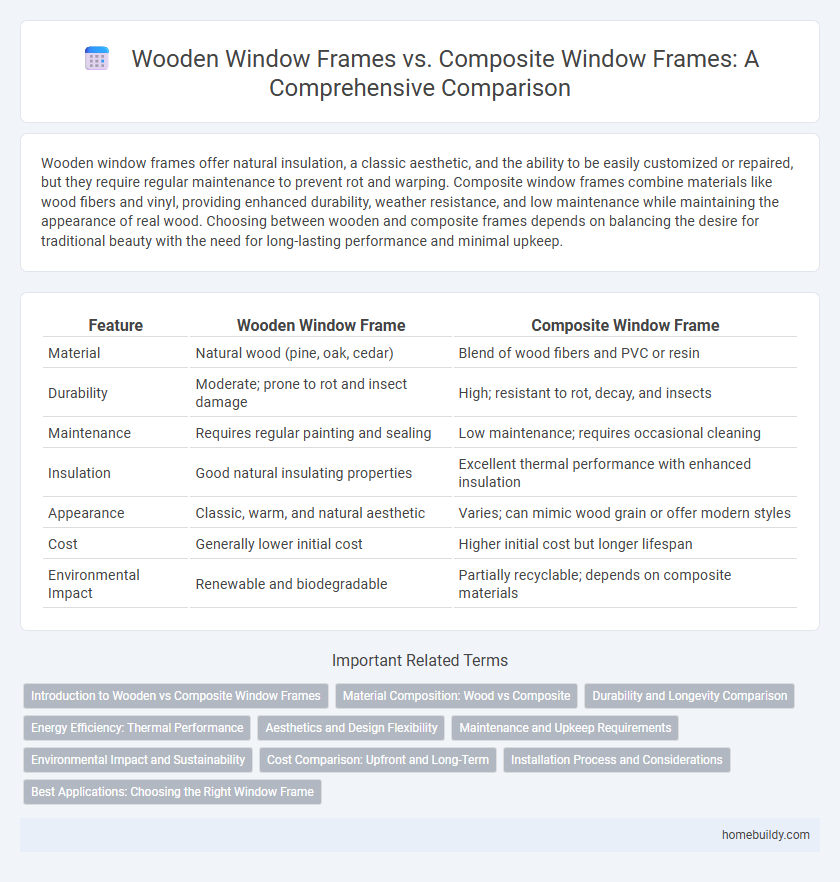Wooden window frames offer natural insulation, a classic aesthetic, and the ability to be easily customized or repaired, but they require regular maintenance to prevent rot and warping. Composite window frames combine materials like wood fibers and vinyl, providing enhanced durability, weather resistance, and low maintenance while maintaining the appearance of real wood. Choosing between wooden and composite frames depends on balancing the desire for traditional beauty with the need for long-lasting performance and minimal upkeep.
Table of Comparison
| Feature | Wooden Window Frame | Composite Window Frame |
|---|---|---|
| Material | Natural wood (pine, oak, cedar) | Blend of wood fibers and PVC or resin |
| Durability | Moderate; prone to rot and insect damage | High; resistant to rot, decay, and insects |
| Maintenance | Requires regular painting and sealing | Low maintenance; requires occasional cleaning |
| Insulation | Good natural insulating properties | Excellent thermal performance with enhanced insulation |
| Appearance | Classic, warm, and natural aesthetic | Varies; can mimic wood grain or offer modern styles |
| Cost | Generally lower initial cost | Higher initial cost but longer lifespan |
| Environmental Impact | Renewable and biodegradable | Partially recyclable; depends on composite materials |
Introduction to Wooden vs Composite Window Frames
Wooden window frames offer natural insulation and classic aesthetics, making them a preferred choice for traditional and historic homes. Composite window frames, made from a blend of materials like wood fibers and resins, provide enhanced durability, resistance to rot, and require less maintenance compared to pure wood. Choosing between wooden and composite frames depends on factors such as climate, budget, and desired longevity.
Material Composition: Wood vs Composite
Wooden window frames are crafted from natural timber, offering excellent insulation and a classic aesthetic appeal. Composite window frames combine materials like wood fibers and PVC, providing enhanced durability, low maintenance, and resistance to moisture and pests. The choice between wood and composite hinges on balancing natural beauty against long-term performance and weather resistance.
Durability and Longevity Comparison
Wooden window frames offer natural insulation and aesthetic appeal but can be prone to rot, warping, and insect damage if not properly maintained. Composite window frames, made from a blend of materials like wood fibers and PVC, provide superior durability, resisting moisture, decay, and temperature fluctuations more effectively. Their enhanced longevity reduces maintenance needs, making composite frames a cost-effective, long-lasting alternative to traditional wooden frames.
Energy Efficiency: Thermal Performance
Wooden window frames offer natural insulation due to the low thermal conductivity of wood, reducing heat transfer and improving energy efficiency in homes. Composite window frames combine materials like vinyl and wood, enhancing thermal performance by minimizing thermal bridging and providing superior airtightness. Energy efficiency ratings for composite frames often surpass those of traditional wooden frames, resulting in better heat retention and lower energy bills.
Aesthetics and Design Flexibility
Wooden window frames offer a timeless, natural aesthetic with rich textures and grains that enhance traditional and rustic architectural styles. Composite window frames provide greater design flexibility, allowing for customizable finishes, colors, and shapes while resisting warping and fading over time. Both materials cater to different aesthetic preferences, with wood excelling in warmth and character and composites in versatility and long-term color retention.
Maintenance and Upkeep Requirements
Wooden window frames demand regular maintenance including sanding, painting, or staining to prevent rot, warping, and insect damage, especially in humid or wet climates. Composite window frames require significantly less upkeep due to their resistance to moisture, rot, and pests, often needing only periodic cleaning to maintain appearance. This difference in maintenance effort makes composite frames a cost-effective and durable choice for long-term window upkeep.
Environmental Impact and Sustainability
Wooden window frames are highly sustainable due to their renewable nature and ability to be sourced from certified forests, offering a carbon-neutral lifecycle through natural carbon sequestration. Composite window frames, made from a combination of recycled materials and plastics, provide durability and lower maintenance but can pose environmental challenges related to recycling and microplastic pollution. Choosing wooden frames reduces environmental impact by supporting biodegradability and sustainable forestry, whereas composites prioritize longevity but require advanced recycling processes to minimize ecological footprints.
Cost Comparison: Upfront and Long-Term
Wooden window frames generally have a higher upfront cost due to the material and craftsmanship required, but they offer excellent insulation and can increase property value over time. Composite window frames often cost less initially and require less maintenance, resulting in lower long-term expenses such as repairs and replacements. When considering total cost of ownership, composite frames typically provide better durability and energy efficiency, reducing utility bills and upkeep costs compared to traditional wooden frames.
Installation Process and Considerations
Wooden window frames require precise measurements and careful handling during installation to avoid warping and ensure proper sealing, often demanding more skilled labor and longer installation times. Composite window frames offer easier installation due to their lightweight, uniform materials, and resistance to twisting or swelling, reducing the risk of alignment issues and minimizing maintenance needs. Considerations include climate impact on wooden frames, where moisture can cause expansion, versus the durability and lower long-term maintenance of composite frames in various environmental conditions.
Best Applications: Choosing the Right Window Frame
Wooden window frames excel in historic restorations and traditional homes, offering natural insulation and aesthetic warmth. Composite window frames, made from materials like fiberglass and vinyl, provide superior durability and low maintenance, ideal for modern buildings and harsh climates. Selecting the right window frame depends on balancing energy efficiency, longevity, and architectural style requirements.
wooden window frame vs composite window frame Infographic

 homebuildy.com
homebuildy.com